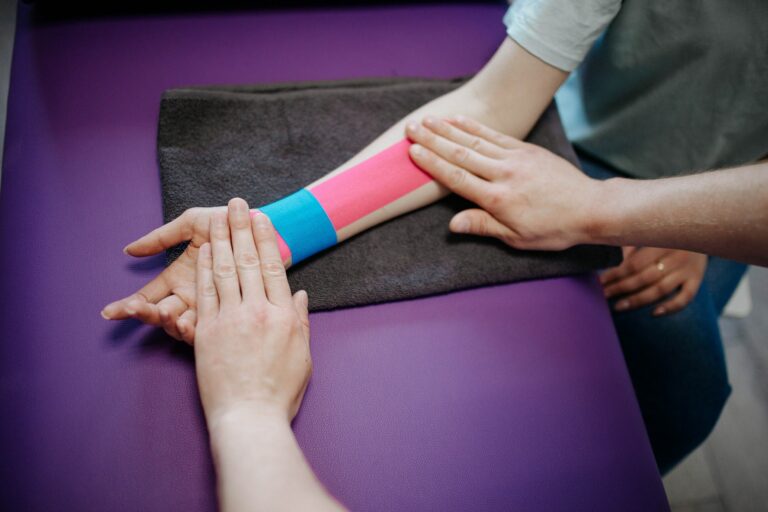You may have seen athletes sporting colorful tape on their bodies during competitions or noticed people wearing it at the gym. This intriguing tape is called kinesiology tape, and it’s not just a fashion statement. Kinesiology taping has become increasingly popular in recent years, providing pain relief and support for both athletes and non-athletes alike. In this blog post, we’ll unravel the mystery behind kinesiology taping and explore how it works, its benefits, and how to apply it correctly.
What is Kinesiology Taping?
Kinesiology taping is a therapeutic technique that involves applying a specialized, elastic tape to the skin to support muscles and joints without restricting the body’s range of motion. It was developed in the 1970s by a Japanese chiropractor, Dr. Kenzo Kase, who sought to create a tape that could provide support while still allowing for natural movement.
The tape is made of a cotton and spandex blend, making it both breathable and water-resistant. It is designed to mimic the elasticity of the skin, providing support without restricting movement. Kinesiology tape can be applied in various patterns and tensions, depending on the desired outcome.
How Does Kinesiology Taping Work?
Kinesiology taping works by lifting the skin slightly when applied, creating space between the skin and the underlying muscles and fascia. This space helps to:
- Reduce pressure on pain receptors: The lifting action of the tape can alleviate pressure on pain receptors in the skin, providing relief from acute and chronic pain.
- Improve blood and lymphatic flow: The tape’s lifting effect can enhance blood flow to the taped area, promoting healing and reducing inflammation. It also helps to facilitate the drainage of lymphatic fluid, further reducing swelling and discomfort.
- Support and stabilize muscles and joints: Kinesiology tape can provide support to muscles and joints by reinforcing their natural function. This can help to prevent injuries and promote proper form during physical activity.
Benefits of Kinesiology Taping
Kinesiology taping offers numerous benefits for individuals dealing with a variety of conditions, including:
- Pain relief from muscle strains, sprains, and other injuries
- Reduced inflammation and swelling
- Enhanced athletic performance and injury prevention
- Improved posture and body awareness
- Support for weak or injured muscles and joints
- Accelerated recovery from injury
Applying Kinesiology Tape Correctly
To get the most out of kinesiology taping, it’s essential to apply the tape correctly. Here are some general guidelines for proper application:
- Clean and dry the skin: Before applying the tape, make sure the skin is clean, dry, and free of oils, lotions, or sweat. This will help the tape adhere properly.
- Cut the tape to the desired length: Measure the length of tape needed for the specific body part, and cut it accordingly. You can also round the corners of the tape to prevent them from peeling up.
- Apply the tape with the appropriate tension: Depending on the desired outcome, apply the tape with varying levels of tension. For pain relief and reduced inflammation, a lighter tension is recommended. For muscle support and stabilization, a moderate to firm tension may be used. Keep in mind that the tape should never be applied so tightly that it restricts blood flow or causes discomfort.
- Follow specific application techniques: Depending on the body part and desired outcome, there are different techniques for applying kinesiology tape. It is crucial to learn and follow these methods to ensure the tape is effective. You can find numerous resources online, such as instructional videos and guides, or consult a healthcare professional for guidance.
- Allow the adhesive to set: After applying the tape, gently rub it to activate the heat-sensitive adhesive, ensuring a secure bond to the skin. It is recommended to wait at least one hour before engaging in physical activity or getting the tape wet to allow the adhesive to set properly.
- Remove the tape carefully: To avoid skin irritation or damage, remove the tape gently and slowly. It is best to remove it in the direction of hair growth and use a bit of oil or lotion to loosen the adhesive if needed.
A Word of Caution
While kinesiology taping can provide numerous benefits, it is essential to remember that it is not a cure-all and should not replace other forms of treatment or rehabilitation. Always consult with a healthcare professional before using kinesiology tape, especially if you have any pre-existing medical conditions, allergies, or skin sensitivities.
In conclusion, kinesiology taping is a versatile and valuable tool that can help alleviate pain, reduce inflammation, and provide support for muscles and joints. By understanding the science behind this colorful tape and learning proper application techniques, you can take advantage of its many benefits and improve your overall well-being.

